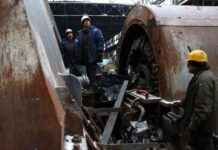The world famous diver and explorer Jacques Cousteau discovered the deep hole off Belize in central America back in 1971.
He called it the world’s best place to dive, and the hole, which is really a sinkhole in the sea, was later named The Great Blue Hole.
Now the british musician Richard Branson, founder of Virgin Group, along with a team of researchers studied the great deep, and made several exciting discoveries with the help of new technology.
It writes CNN.
The Great Blue Hole is a popular tourist spot and every year the diving thousands of travelers in jordfaldshullet.
the Hole is over 300 meters wide and 125 meters deep.
It is a large area to cover, but the team had from the start as a target to map the depths, which was done via submarines.
On the way scanned to the hole, which was then made into a 3D map.
– We have made our complete 360-degree sonar-map, and the map is now almost finished. It looks really cool, it is such a mesh-stored sonar scan of the entire thousand-foot-in-diameter-hole, tells Erika Bergman, oceanographer and operations manager on the expedition.
One of their discoveries was found by the stalactites. Stalactites can be seen usually in limestone caves and called in the general case of the stalagmite, since it is a tap, which hangs down from the ceiling.
In The Great Blue Hole, have never seen it before now.
because of a layer of hydrogen sulphide (hydrogen sulfide, red.) that descends over the divers at about 90 meters depth, it is also quite dark, as svovlbrinten swallows all the light.
– You lose all the caribbean sunlight, and it will be just completely black, and it is quite anoksisk (lack of oxygen, red.) down there with absolutely no life, tells Erika Bergman.
Besides Richard Branson was also Jacques Cousteau’s grandson Fabien Cousteau in the expedition, which took place in december.
the Team live-streamed, among other things, a of throughout the diving operations.
Richard Branson poses with the team, which also included Jacques Cousteau grandson Fabien Cousteau. Photo: PR/Aquatica Submarines
By using submarines photographed the team throughout the jordfaldshullet to make a 3D map. Photo: PR/Aquatica Submarines








